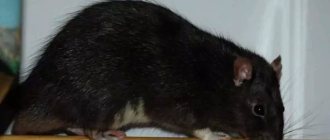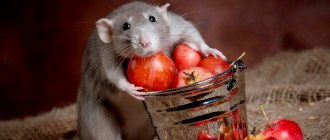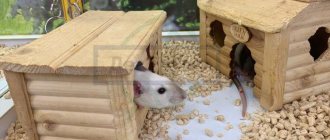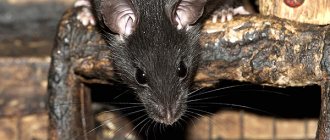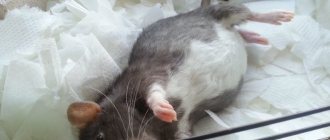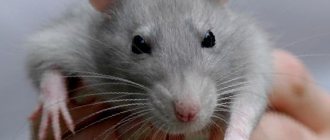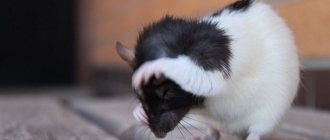Types of crossing
Breeders of decorative rats practice 2 main types of mating - interbreed and intraspecific. The latter is divided into several more subspecies.
Outbreeding
It involves crossing purebred individuals of the same breed, but having absolutely no family ties. This type of breeding is considered the safest in terms of health and survival of the offspring. However, outbreeding has one significant drawback - after several generations, the required breed trait can be significantly modified.
Linebreeding
This type of crossing is also called linear crossing. The peculiarities of lanbreeding include the choice for mating of a pair of animals that have one close ancestor. As a result, homozygous genes are fixed in the rat pups, and, accordingly, the required characteristics are fixed.
Outcrossing
It is used when it is necessary to obtain a large litter with a pronounced breed characteristic. Animals obtained by outbreeding are selected for crossing. The main requirement is that the male and female must not have common relatives up to the 5th generation.
Inbreeding
This type of breeding of ornamental rats involves obtaining offspring from a female and a male who are close relatives. As a result of inbreeding, the birth of non-viable or weakened rat pups is possible. To avoid such consequences, experienced ratologists are involved in the selection of animals for mating.
Experienced breeders use all of the listed types of breeding ornamental rats to obtain the desired phenotype. However, as experience shows, it is extremely rare to predict the result of crossing rodents with 100% accuracy.
Inbreeding
Inbreeding is not a good idea. Mating relatives can cause genetic problems.
Some breeders do inbreeding, which they call line breeding, to produce a rat of a certain color. Usually in this case, rat relatives are mated.
Some studies show that inbreeding in wild rats leads to a shorter lifespan for the rats. Therefore, it is suspected that inbreeding in domestic rats will lead to the same result.
There is a lot of inbreeding going on in the rat business as they have huge cages where a huge number of rats live and breed without any concerns about relatives. Or they don't keep track of diseases or legacies.
Mass-bred rats tend to have a much shorter lifespan than rats bred by responsible breeders.
Preparation for crossing
Many people believe that there is nothing complicated in crossing rodents - it is enough to simply put two individuals of opposite sexes in a cage and leave them together for several days. However, for successful breeding of ornamental rats, it is necessary to keep in mind several nuances.
Pair selection
The choice of candidates for mating should be approached thoroughly, because the health and well-being of the rat pups directly depends on the future parents. Firstly, only adult, sexually mature animals are allowed for breeding. Despite the fact that decorative rats reach reproductive age by 5-6 weeks, it is not recommended to cross rodents so early.
Delivery too late can also have adverse consequences. If a rat gives birth for the first time after reaching 8 months of age, the fetuses may simply get stuck in the narrow birth canal. Then, without the help of a veterinarian, the pet’s life cannot be saved. The optimal age for mating rodents is 5-6 months.
It is recommended to choose a female for mating who will be the same age as the male or even slightly older than the gentleman. But in no case – not younger. This approach increases the likelihood of having strong, viable offspring.
Diet
Animals for crossing must be moderately well-fed and have a good disposition. Excessive thinness or obesity can lead to the birth of sick rat pups. If body weight is slightly higher than normal, 5-7 days before the planned mating, animals can be put on a low-calorie diet, consisting mainly of succulent feed.
The female's menu also includes additional protein dishes - eggs, low-fat cottage cheese, kefir, chicken, beef, boiled fish. Protein-rich foods will provide the future mother’s body with high-quality building material for the formation of embryos.
Also, cereals (wheat, oats, rice, millet) are introduced into the rat’s diet - healthy sources of carbohydrates that provide the female with the energy she will need for bearing babies, childbirth and good lactation.
Pairing
Fertilization of the female can occur during the period of estrus, which in decorative rats occurs once every 5 days and lasts on average from 12 to 18 hours. The onset of a favorable period for placing a male can be judged by the female’s vagina - it acquires a characteristic burgundy hue, swells and opens slightly.
Also, during estrus, the behavior of female rats changes - they playfully twist their hips, stretch out their hind legs, shake their ears, and emit an inviting squeak. If you stroke a female during this period, she throws back her head and bends her whole body.
The final stage of a female's estrus is the so-called heat, during which the rat is ready to actively mate with the male. The caged couple enjoys lovemaking throughout the whole day, breaking for a snack and a short rest. Numerous sexual acts are simply necessary for one hundred percent success in conception.
One mating lasts less than a minute - the boy climbs on the girl, lightly biting the skin in the area of the withers with his teeth. If everything went well, pregnancy occurs. The interesting situation of the rat is evidenced by the absence of another heat cycle.
Rat pregnancy
Pregnancy of a decorative rat lasts on average 3 weeks, +/- a couple of days. In the initial stages, the pet’s appearance does not in any way indicate its interesting position. But the character changes noticeably - the animal experiences mood swings, drowsiness appears, and vital activity decreases.
After 2 weeks, the female’s abdomen becomes noticeably rounder. The body of the female standing on her hind legs is shaped like a pear. To successfully carry a pregnancy to term, when caring for a female, you must adhere to the following rules:
- Organize a diet rich in vitamins and animal protein for the expectant mother. The rat's menu must include fermented milk products and lean meat, as well as fresh fruits and vegetables, nuts, seeds, and cereals. In addition, care must be taken to ensure there is fresh water in the drinking bowls.
- Remove dangerous toys from the cage - ropes, ladders, shelves, bridges. If a girl accidentally falls while playing, the pregnancy may end.
- Provide a comfortable microclimate in the room with the cage - protect the pet from bright sunlight, cold and drafts. The immune system of a pregnant rat is greatly weakened, so the female can catch a cold from the slightest breath of wind.
- Surround the expectant mother with care. A rat in position especially needs the attention of the owner. During this difficult period, she should feel the love and support of a person. Therefore, you must remember to take the female in your arms, stroke her, and talk to her. Of course, taking into account the pet’s mood, because in pregnant rats it often changes.
- Set up an individual house in the cage for the expectant mother. In it she will be able to retire and relax peacefully. Sometimes the female builds a future nest in the house.
- After 2 weeks of pregnancy, replace wood filler with soft paper napkins. This is necessary to ensure that dust and other small fractions do not enter the respiratory tract of newborns. Also, napkins are very convenient for nesting, when the expectant mother takes everything that gets in her way to the intended place of birth.
In addition, it will be necessary to protect the expectant mother from stress and aggression from her cagemates. A few days before giving birth, it is better to place the remaining rats in a separate housing. This way, the female will be able to calmly give birth and feed the babies.
If there are still 2-3 days left before the birth, and bloody discharge appears from the pregnant rat’s vagina, you must immediately take the animal to the veterinary clinic. Bleeding can be dangerous not only for the pups, but also for the life of the female.
How does childbirth go?
Normally, birth in decorative rats lasts 1-1.5 hours. At this crucial moment, you should not disturb the female. Guided by natural instincts, she herself will cope perfectly with the birth of babies.
The imminent birth is signaled by the pet's elongated body with sunken sides. During childbirth, no one should be in the room with the cage; you will also need to close all windows (to avoid drafts) and dim the lights.
As the pups pass through the birth canal, the female sits down a little and helps herself with her paws. She gnaws the umbilical cord herself and licks the babies, cleaning them from the remnants of the amniotic sac.
In addition, licking acts as a kind of massage, which helps newborns take their first breath and make a corresponding squeak. The absence of such a signal signals the death of the rat pup; in such a situation, the mother simply eats it.
When all the pups are born, the new mother begins to feed the offspring. On average, a rat gives birth to 6-10 babies, but sometimes more. Decorative rats have only 12 nipples. Therefore, if a larger number of rat pups were born, the female divides them into 2 groups and feeds them in turn. Lactation in rats is well developed, so there is enough milk for everyone.
The following symptoms indicate the need to consult a veterinarian: the rat’s labor lasts more than 2 hours, bleeding has appeared, the animal is worried, and the skin has turned pale.
Factors
The success of settlement depends on many factors, such as:
Character of animals.
The calmer and more balanced the animals, the easier the placement will be. At the same time, you should not rely on assessing the character of an animal only on the basis of its communication with you - often animals, peaceful and affectionate with people, are quite aggressive towards their own kind. Therefore, only those who already have several rats living in the same group can evaluate their character and understand what to prepare for.
Age of animals.
The younger the rats being housed, the easier the placement. The best age for adoption is from about 6-7 weeks to 2.5 months. Later than this age, rats usually begin hormonal changes that last 5-8 months, which significantly increases the struggle for leadership in the pack and complicates the process of moving in, and a younger rat pup is still too weak to meet unfamiliar rats that may behave aggressively. It is worth considering that you should not share old rats (more than 2 years old) with old rats - the stress and hassles that are inevitable during sharing can cause irreparable harm to their health. It is better to place a couple of baby rats with older rats (1.8-2 years) and aged rats - they will be busy playing with each other and will not bother the adults too much.
Like/Hate.
Sometimes a move-in that is ideal in all aspects leads to failure or incredible difficulties only because the rats being moved in did not like each other “at first sight.” It's hard to say why one rat might not like another, but the fact remains. You can often see the opposite situation: a rat breeder, preparing for a long process fraught with problems, is surprised to discover that the rats clearly sympathize with each other, became friends from the first meeting and even moved in together themselves. But you shouldn’t hope for such an outcome; it’s still rare.
Experience in rat breeding and housing.
The more rats the owner kept, the more additions he carried out, the easier it would be for him to carry out another one. No recommendation, no rule can replace actions based on intuition. It is always very important to see and understand in time that something has gone wrong, or to relax and not disturb the rats if everything is in order.
Caring for the rat and offspring
When the offspring are born, the new mother and babies will require special care. To make the female and her pups feel comfortable, the following recommendations should be followed:
- do not touch babies with your hands until they reach the age of 10-12 days;
- provide the female with a complete diet, feed her not only with industrial food, but also with natural food;
- do not place other rats in the cage;
- maintain cleanliness in the cage - in the first days after birth, you will have to remove the soiled litter and waste using a tablespoon.
Sometimes the rat refuses to feed the pups. In such a situation, you can look for a nurse for the brood, for example, among other breeders or in a pet store. You can also feed your babies yourself with baby formula using an insulin syringe.
After 2 weeks, the pups are ready to meet a person. If there are no objections from the mother, they can gradually be taught to be held. At the age of 5 weeks, males will have to be placed in a separate cage, otherwise they will begin to mate with their mother and sisters. Then new pregnancies cannot be avoided.
If a running wheel is installed in a cage with pups, it is necessary that the gap between the floor and the projectile is sufficient so that the animals can move freely there. Otherwise, children may get stuck under the wheel, which can lead to suffocation.
Recommendations
A few general recommendations to make moving in easier:
Don't put cages next to each other. This is probably the main mistake of housekeepers: everyone tries to place the cage with newcomers closer to the cage with old-timers, so that the rats can “communicate” and get used to each other. In fact, this leads to the opposite effect: an increase and accumulation of aggression in rats who see a strange animal, a rival, but cannot reach it. Later, upon direct acquaintance, your old-timer will over and over again pour out all the accumulated aggression and irritation on the newcomer. This can lead to unpleasant consequences and make it impossible to move in before it has even begun. Therefore, place the cells as far apart as possible.
Take your time.
When moving in, you shouldn’t rush or force things; you should always give the rats time to get used to the situation and get used to the new member of the pack.
Go back.
If everything doesn’t go according to plan, then don’t be afraid to take a step back to the previous stage.
Keep calm.
Rats are excellent at recognizing your emotions, so try to calm down and not be nervous when introducing rats: your nervousness can be passed on to the animals. Therefore, before the process, it is better to get your nerves in order and stop trembling in your knees - this will help both you and the rats.
Don't be afraid to ask questions. In the appropriate topic on the forum, you can always ask for help or simply ask a question that interests you.
What to feed baby rats
For the first 10-14 days of their lives, babies feed on mother's milk. After this period of time, the pups can be fed solid food. The diet of the brood, depending on age, looks approximately as follows:
- 1-7 days - milk or infant formula;
- 7-14 days – milk with a small addition of grain feed;
- 14-21 days - milk with grain feed, children's dairy-free porridge.
From three weeks of age, the diet of rat pups becomes more varied. You can gradually include pieces of soft fruit (pear, banana), baby purees (vegetables, fruits and meats), seeds, fermented milk products (cottage cheese, kefir, yogurt, fermented baked milk) in your children’s menu.
Also, as they grow older, the frequency of feeding the brood decreases. If newborn rat pups eat every 2-3 hours, then closer to the second week of life - once every 4 hours. And then they completely switch to an adult diet - 2-3 times a day.
Breeding rats at home imposes great responsibility on the novice breeder - for the life and well-being of the parents, especially the female, and future offspring. Therefore, you should not engage in crossing rodents without careful preliminary preparation. Only an organized approach to breeding ornamental rats can ensure guaranteed success in this difficult task.
What sound does a wounded animal make?
May scream, chirp, or remain silent due to painful shock. Most often, domestic rats suffer injuries to their paws: a torn claw, a cut, a splinter, a broken toe or tail, or a pinched tail.
If you find that your pet has injured itself, calm down, don’t panic, give it first aid. Treat the wound with an anti-inflammatory agent. Try to stop the bleeding with hydrogen peroxide.
